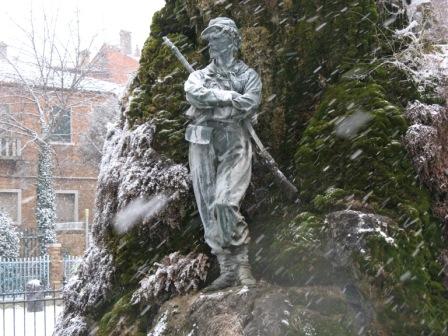I’m not a big fan of Carnival in Venice. The only bigness I can evince where this annual demolition derby is concerned is a jumbo-size package of the old Aristotelian pity and terror.
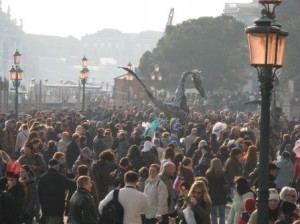
That’s not completely true: I don’t feel pity.
But this year I decided to take a different approach. When Carnival erupted last Sunday (after several premonitory tremors) I thought I’d imagine it was something that could be fun, amusing, diverting, worth the trip. Not for me — I’ve figured out how to make it fun for me but it doesn’t involve costumes or the Piazza San Marco — but just going with the idea that it could be entertaining for the thousands upon thousands of people who come to Venice expecting to enjoy themselves, at least, if not enjoy everybody else.
By which I mean, enjoy being squashed like a grape in a winepress by your fellow humans.
So far, it’s working. I had a fine time on Sunday afternoon. But that’s because I made a point of not going to the Piazza San Marco. The Gazzettino reported that some 90,000 people were there. They certainly didn’t need me, even if there had been room.
The first years I was here I did go, at least a few times, to the Piazza San Marco, the gravitational center of the festivities. It was all so new and strange, and memory reports that there weren’t quite so many thousands. Memory may be lying but it was fine anyway. Perhaps the novelty of the situation carried me over the crush, as it may well do to people today.
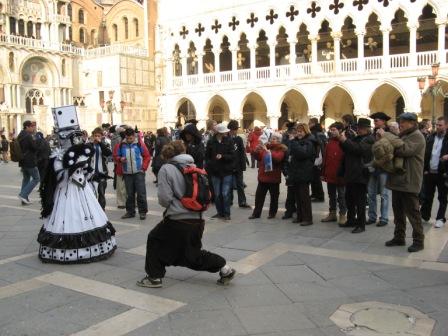
Then there was a hiatus, partly because I didn’t enjoy the winepress experience and also because what was going on there seemed strangely unfestive: Loads of people in costume (95 percent of which seemed to be identical), walking around just looking at each other, striking attitudes, or taking pictures of each other with or without tourists posing next to them. The nadir is occupied by the people in costume who charge money for allowing themselves to be photographed with your cousin or your kid. And they can make a bundle.
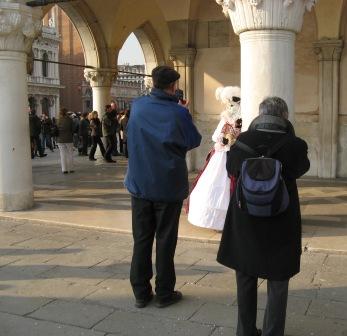

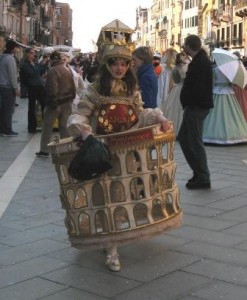
Then we came to Castello and I discovered something of the way Carnival was, decades ago, before the event was trampled by the tourism behemoth. Kids and families and dogs, and relatively few tourists. And did I mention the kids?

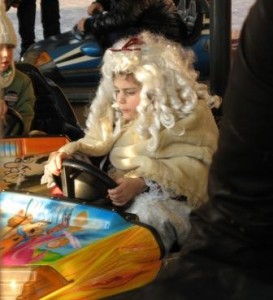
Perhaps I’m going senile, or perhaps it’s because the confetti-throwing and occasional Silly String-spraying and strolling around have no evident commercial focus, but I think the downtown version of Carnival beats San Marco in straight sets. Here, if you see somebody taking a picture of a person in costume, it’s almost certainly a besotted relative.
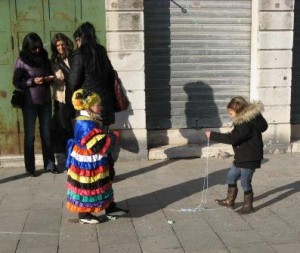
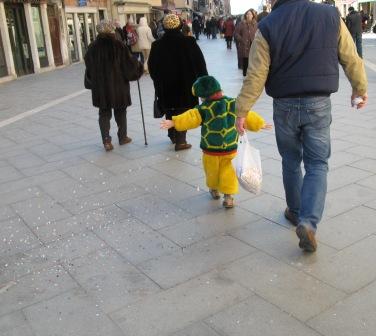
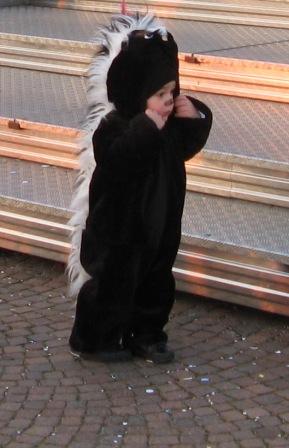

I
If you start to look around, you begin to notice how little it really takes to dress up and play Carnival. There were people who were looking great with only a hat, or a wig, or a moustache or whiskers scribbled on with a black marker– even the simplest mask imaginable just barely covering the eyes. No plumes, no sequins, no layers of painted papier-mache. It really works.
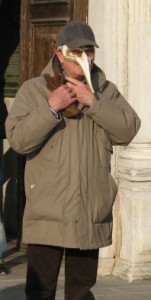
The first Sunday of Carnival (February 7 this year) was Opening Day, one of the maximum moments, as you can imagine. The others are Fat Thursday (Giovedi’ Grasso), and Fat Tuesday (Martedi’ Grasso). And the weekend between them. If the weather is beautiful — as it was on Sunday — it can feel like a party even if you don’t do anything special. If it’s really cold, overcast, windy or rainy, obviously the merriment becomes shredded and forced. This isn’t Rio.
Next chapter: I’ll be tossing out a few festive fistfuls of history, gathered from a large bag of brightly-colored bits of trivia.
Here’s a sample. “Confetti” here refers to the sugared almonds which are given to wedding guests. What speakers of English (and French, German, Spanish, Swedish and Dutch) call confetti — brightly-colored bits of paper — here are called coriandoli (ko-ree-AN-dolee). Why?
Because back in the Olden Days, Carnival revelers would toss all sorts of things around or at or on each other — eggs full of rosewater was one hugely amusing toy to everybody except the women who were on the receiving end. People would also toss various tiny edibles, particularly coriander seeds, which were used in pastries. Then they became bits of sugar pretending to be coriander seeds. Only much later — in 1875 — did flakes of paper begin to be used instead, which is an entirely different story. People who had always called the flying fragments of food “coriandoli” merely transferred to term to the newer-fangled form.

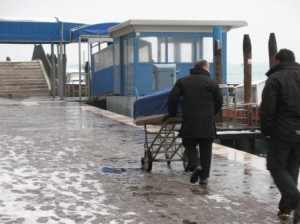 Two men emerged from the hospital through an unidentified door and began walking down the fondamenta with us. Somebody was with them. Somebody who was going — in fact, had already gone — in a radically different direction.
Two men emerged from the hospital through an unidentified door and began walking down the fondamenta with us. Somebody was with them. Somebody who was going — in fact, had already gone — in a radically different direction.
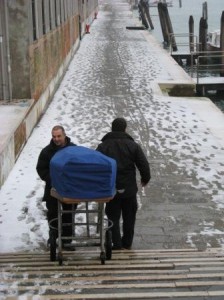
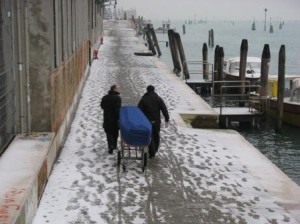
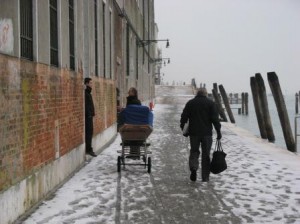
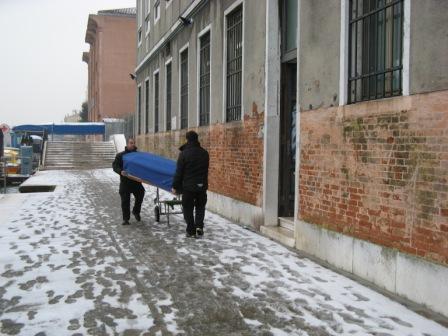
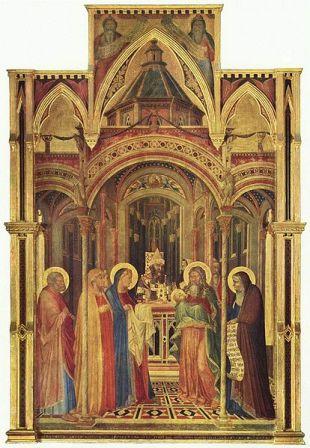

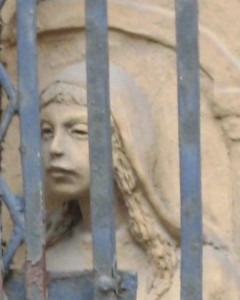
 Lest you think that this effusion represents the apex of Victorian nostalgia — the anonymous donor clearly beat Mussolini to the public declaration of worship of their Latin forebears — let me note that a statue of Cerere also stands atop the Chicago Board of Trade, as well as appearing on the Great Seal of the State of New Jersey, holding a cornucopia. These notions die hard. Or not at all.
Lest you think that this effusion represents the apex of Victorian nostalgia — the anonymous donor clearly beat Mussolini to the public declaration of worship of their Latin forebears — let me note that a statue of Cerere also stands atop the Chicago Board of Trade, as well as appearing on the Great Seal of the State of New Jersey, holding a cornucopia. These notions die hard. Or not at all.